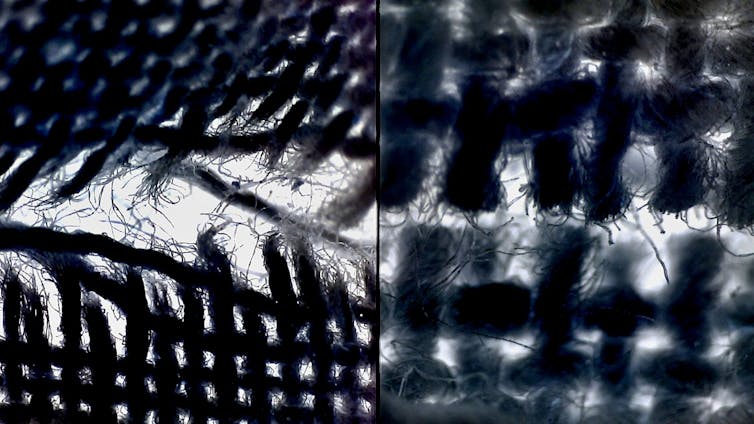Knife crime is common but difficult to investigate. Robots can help
- Written by The Conversation

The following article contains material that some readers might find distressing.
Around the world, knives are a popular weapon of choice among criminals. In Australia, for example, they are the most common weapon used in homicides. And in countries such as the United Kingdom and Canada, knife crime has recently been on the rise.
As common as they are, stabbings are also difficult to investigate. Our new study, published this week in WIREs Forensic Science, presents the most comprehensive review to date of the methods used by forensic investigators for the reconstruction of knife crimes. It also highlights the limitations of these methods and introduces mechanical and robotic stabbing machines as a solution.
These technologies could significantly enhance forensic science and criminal investigations in the pursuit of justice.
An intensely personal act of violence
Stabbing is an intensely personal act of violence, carefully planned or opportunistic. It reflects not just an intent to harm but also a direct, physical engagement with the victim.
Stabbings are also typically associated with high levels of aggression and frenzied attacks. For example, Joel Cauchi fatally stabbed six people and injured ten more in just three minutes during an attack at a Sydney shopping centre on November 13, 2024.
Forensic investigators will rely on a range of evidence to investigate a stabbing. For example, they will gather statements from any witnesses. But witnesses’ memory can be affected by issues such as shock, lighting conditions or their vantage point.
Forensic investigators will also gather physical evidence left behind after a stabbing. This can include bloodstain patterns, sharp-force damage in wounds and clothing, and impression evidence. It can also include trace evidence such as DNA, fibres, soil, glass and pollen from the victims clothing or suspected weapon.
This physical evidence is crucial for the next step of a criminal investigation: reconstructing a crime scene.
A forensic puzzle
Investigators reconstruct a crime scene to determine the type of weapon used, estimate whether the stabbing was intentional or not and how forceful it was. But many variables complicate the analysis.
For example, the attacker’s (or attackers’) physical characteristics such as their size, strength or preferred hand, their familiarity and experience in handling knives can all influence the stabbing motion. So too can the characteristics of a knife.
The victim’s build, positioning, area of impact, and even the number of clothing layers they have on can also affect how a blade enters the body. For example, stabbing with a kitchen knife and slashing with a machete leave vastly different injuries, just as a thick jacket can slow or deflect a blade.
Reconstructing a stabbing is a forensic puzzle. It requires a combination of scientific analysis, investigative techniques and the collaborative effort of experts. Each specialist provides a comprehensive perspective on the victim, the weapon, the manner in which it was used, and the impact of the surrounding environment.
An accurate simulated stabbing
In many stabbing investigations, it is necessary to confirm evidence through simulation.
Our new research focuses on the different ways stabbing simulations are conducted. It provides an overview of current methodologies used to reconstruct sharp-force events, especially considering the role of clothing in the reconstruction.
A well-planned simulation must account for key variables affecting damage to the body and textiles. These factors fall into three categories:
- Pre-impact (garment type, weapon and assailant-victim characteristics)
- Impact (stabbing method, force and angle)
- Post-impact (body decomposition, manipulation, contamination and environmental effects).
While adding more parameters can improve the realism of a simulation, it may also introduce complexity that reduces accuracy. Because of this, careful planning is pivotal.
A mix of methods is best
The choice of simulation method depends on available personnel, tools and funding. Approaches are typically categorised as manual or mechanical, with emerging research exploring the potential of robotic systems.
Manual simulations rely on human effort to replicate stabbing motions. They remain widely used in forensic testing and provide valuable insights into wound characteristics, biomechanics, and protective materials. But they can be subjective, particularly in force estimation and motion consistency.
Mechanical simulations address this issue by using devices for controlled, repeatable tests. While they reduce variability, they are often limited by restricted motion, force constraints, and a lack of standardisation in forensic protocols.
Robotic simulations offer a promising alternative. They combine the adaptability of manual approaches with the precision and repeatability of mechanical systems.
However, their forensic application is still being developed. They also face challenges such as cost, accessibility, professional expertise and the need for validation in real-world casework.
Our research suggests that combining manual simulations with robotic and mechanical systems can enhance the accuracy and reliability of stabbing simulations. The manual approach can be used to train robotic systems that replicate human actions while ensuring consistent and controlled measurements.
By adopting this combined approach, forensic science can bridge crucial gaps in crime scene reconstruction. In turn, this would improve the interpretation of stabbing incidents and the pursuit of justice.







